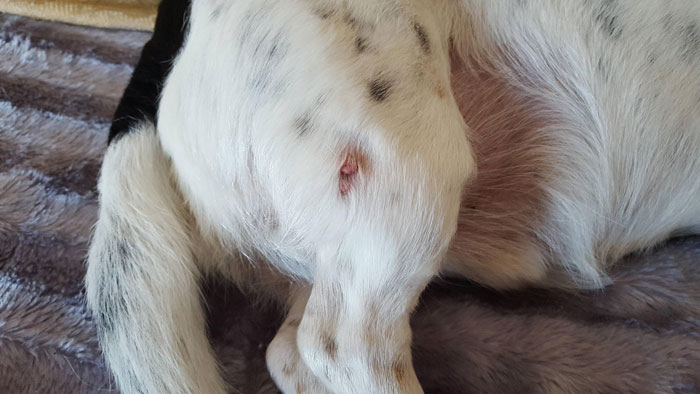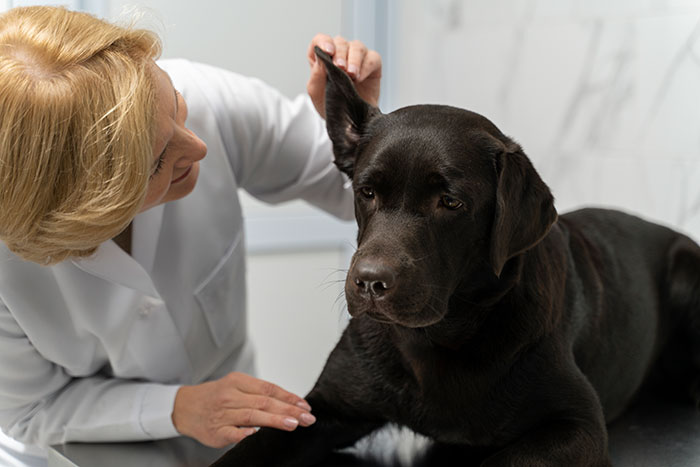Disclaimer:Please refer to the information in this article as a guide only. If you are worried about your pet’s health or behavior, it’s best to contact your veterinarian.
Skin tags on dogs are benign growths that can appear at any age and are usually harmless. However, it’s crucial to understand how to identify and treat these growths properly to prevent any discomfort or future complications.
HighlightsSkin tags on dogs are benign and can occur due to friction and genetics.A skin tag appears as a fleshy pedicle, often near skin folds.Removal options include surgical, cryotherapy, or laser therapy.Preventive measures include a proper diet and regular vet check-ups.Skin tags can be removed at home but consult a vet if unsure.
The information provided herein is for informational purposes only. Please refer to ourdisclaimerfor more details..
Table of ContentsWhat Causes Skin Tags On Dogs?Identifying Skin Tags on DogsTreatment Options for Skin Tags on DogsPreventing Skin Tags on DogsEnsure a Proper diet for healthy dog skinRegular Check-UpsCan You Remove Skin Tags on Dogs at Home?How to remove Skin Tags on Dogs eyelids?How to Remove Skin Tags on Dogs Naturally?Will Tea Tree Oil Remove Skin Tags on Dogs?Conclusion
What Causes Skin Tags On Dogs?

Image credits:JCC87
Skin tags are small, fleshy growths that protrude from the skin’s surface. They can appear in various sizes and shapes and are commonly found in areas with skin folds. These growths are usually harmless and non-cancerous, causing minimal irritation to your furry friend.
Dog skin is more prone to fibrous tags due to the constant rubbing and friction of skin folds. Additionally, genetics, old age or underlying health conditions can increase the likelihood of skin tag development.
While the exact cause of this condition is unknown, they are believed to be a result of skin rubbing against skin or clothing, collars etc. This rubbing causes local irritation in epidermis outer skin layer, leading to the formation of skin tags.
Dogs with skin folds, such as pugs, bulldogs are more susceptible to developing skin tags due to the buildup of moisture and friction in those areas. However, in general, dog skin tag originates form hyperplasia or uncontrolled growth of fibrovascular cells of any breed in old age.
Identifying Skin Tags on Dogs
Identifying skin tags on dogs is an essential step in managing their skin health. These skin growths are usually harmless, but if left untreated, they may cause inflammation and discomfort to your furry friend.
SignDescriptionSizeAre usually small in size, but they can grow larger over time.ColorTypically, are the same color as your dog’s skin, sometimes resembling ticks without legs.TextureThese are usually soft to the touch and moveable.IrritationThese can be itchy, if your dog scratches or chews at them, they may become red and inflamed.SignSizeDescriptionAre usually small in size, but they can grow larger over time.SignColorDescriptionTypically, are the same color as your dog’s skin, sometimes resembling ticks without legs.SignTextureDescriptionThese are usually soft to the touch and moveable.SignIrritationDescriptionThese can be itchy, if your dog scratches or chews at them, they may become red and inflamed.
SignDescriptionSizeAre usually small in size, but they can grow larger over time.ColorTypically, are the same color as your dog’s skin, sometimes resembling ticks without legs.TextureThese are usually soft to the touch and moveable.IrritationThese can be itchy, if your dog scratches or chews at them, they may become red and inflamed.
SignSizeDescriptionAre usually small in size, but they can grow larger over time.SignColorDescriptionTypically, are the same color as your dog’s skin, sometimes resembling ticks without legs.SignTextureDescriptionThese are usually soft to the touch and moveable.SignIrritationDescriptionThese can be itchy, if your dog scratches or chews at them, they may become red and inflamed.
SignSizeDescriptionAre usually small in size, but they can grow larger over time.
SignSize
Sign
Size
DescriptionAre usually small in size, but they can grow larger over time.
Description
Are usually small in size, but they can grow larger over time.
SignColorDescriptionTypically, are the same color as your dog’s skin, sometimes resembling ticks without legs.
SignColor
Color
DescriptionTypically, are the same color as your dog’s skin, sometimes resembling ticks without legs.
Typically, are the same color as your dog’s skin, sometimes resembling ticks without legs.
SignTextureDescriptionThese are usually soft to the touch and moveable.
SignTexture
Texture
DescriptionThese are usually soft to the touch and moveable.
These are usually soft to the touch and moveable.
SignIrritationDescriptionThese can be itchy, if your dog scratches or chews at them, they may become red and inflamed.
SignIrritation
Irritation
DescriptionThese can be itchy, if your dog scratches or chews at them, they may become red and inflamed.
These can be itchy, if your dog scratches or chews at them, they may become red and inflamed.
If you notice any changes in size, shape, color, or if your dog seems to be experiencing discomfort, it’s important to consult a veterinarian to ensure that the growth is indeed a skin tag and not a more serious condition this will help you identify and distinguish skin tags from other similar-looking growths, such as papilloma, warts, or cancerous tumors.
Treatment Options for Skin Tags on Dogs
Once you have confirmed that your dog has a skin tag, it’s important to consider the most suitable treatment option. While most skin tags are benign and non-cancerous, they may still cause discomfort or skin infection to your pet. One of the most common methods of removal is surgical removal, which involves cutting the skin tag off with a scalpel or scissors. This procedure is usually performed under local anesthesia to minimize any pain or discomfort for your dog.
If your dog has a large benign peduncle or multiple lesions, your veterinarian may recommend using cryotherapy or laser therapy instead. Cryotherapy involves freezing the skin tag with liquid nitrogen, while laser therapy involves using a laser to burn off the overgrown tissue. Both these methods are minimally invasive and you may need repeated sessions depending on the size and location of lesions.
It’s important to note that one must be able to differentiate skin tags from other skin problems. For example, papilloma refers to viral growths that resemble skin tags but can spread to other parts of your dog’s body. If you’re unsure about the nature of your dog’s skin tag, consult your veterinarian for a professional diagnosis.
Preventing Skin Tags on Dogs

Image credits:freepik
If you are a pet owner, you know how important it is to keep your furry friend healthy and happy. Part of that responsibility includes taking care of their skin, which can be prone to various skin lesions and irritations. While you may not be able to eliminate the risk of skin tags entirely, there are steps you can take to prevent them from occurring.
Ensure a Proper diet for healthy dog skin
A balanced diet can go a long way in maintaining your dog’s overall health and minimizing the likelihood of skin tag development. Ensure that your pet’s diet includes essential nutrients like omega 3 and 6 fatty acids, vitamins like Vitamin A and E, and minerals like Zinc that are needed for healthy skin.
Regular Check-Ups
Regular veterinary check-ups are crucial in identifying any skin issues early on and treating them before they become a more significant problem. Your veterinarian can also provide you with specific advice and guidance on how to care for your dog’s health and prevent skin issues from occurring.
In this last section, we will be answering the Frequently asked questions from pet owners:
Can You Remove Skin Tags on Dogs at Home?
Here are the steps to safely conduct this procedure:
After removing the skin tag, monitor the area for any redness, swelling, or bleeding. If you notice any signs of infection, consult with a veterinarian immediately.
Remember that not all skin tags need to be removed, and removing them can cause some discomfort to your pet. If you’re unsure about the size or location of the skin tag, consult with a veterinarian before attempting to remove it at home.
How to remove Skin Tags on Dogs eyelids?
How to Remove Skin Tags on Dogs Naturally?
Skin tags may not resolve on their own, while benign skin tags that are not spreading can be removed at home using sterile equipment. However, there are natural ways that may help soothe and remove these tags. Aloe Vera has soothing properties, Apple cedar vinegar, and tea tree oil can help dehydrate and dry the lesions.
Will Tea Tree Oil Remove Skin Tags on Dogs?
Tea Tree oil is a natural oil extracted from the Australian tee tree leaves, traditionally used for treating skin issues like warts and acne, is thought to have dehydrating and antimicrobial properties. However, there is no scientific evidence to support these theories. Tree Oil has dehydrating properties , it removes the water content of the skin tag and the skin growth gradually shrinks due to excessive drying.
You can learn more about the medicinal uses of tree oil in thisreview.
Conclusion
Skin tags are usually benign and harmless growths, just a matter of cosmetic concern; however, they may become cancerous and may become prone to cause inflammation or infection. Location of the lesion is important, skin growths close to the eyes can cause irritation and infection of the eye and in such cases, a professional Veterinary treatment is recommended.
Uncomplicated painless tags can be safely removed at home using sterile techniques. There are some natural ways to deal with these fibrous peduncles, like applying tea tree oil and aloe Vera.
All in all, timely identification of the nature of the lesion, whether benign or cancerous is key to dealing with skin health problems of your dog. A balanced diet rich in Omega 3 and 6 and essential vitamins like Vitamin A can help a great deal in maintaining the skin health of your dog.
3Kviews3Kviews
Pet Wellness